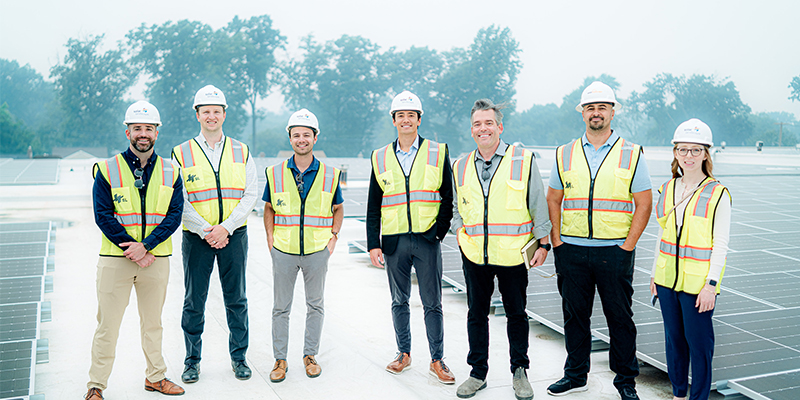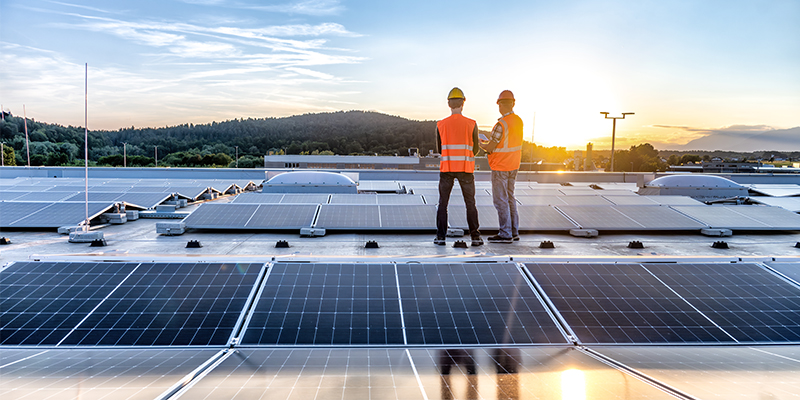Environmental, Social and Governance (ESG) and decarbonization initiatives can yield significant advances across the industry, from the important climate benefits to improved investor and community relations. While these are not new concepts – the first solar panels date back to 1954 – they are fresher to commercial real estate as owners and developers evaluate how to retrofit existing properties and incorporate elements of sustainability into their projects.
A panel of commercial real estate ESG leaders took to the stage at I.CON East this week to share how their companies have embraced these goals and moved them forward to benefit both their businesses and the communities where their properties are located.
“There’s a big drive to decarbonize in every industry, with companies tracking greenhouse gas emissions and making disclosures” said David Crist, CEM, director of sustainability with ARCO Design/Build. “Scope 3 [the U.S. Environmental Protection Agency’s forthcoming guidelines on measuring emissions that are the result of activities from assets not owned or controlled by the reporting organization, but that the organization indirectly affects in its value chain] will have a big impact but is yet unknown. At ARCO, we’re looking at embodied carbon, or the emissions from the materials going into the building. Ninety percent of a building’s emissions are embodied, and the other 10% are operational.”
Madeline O’Donnell, senior ESG analyst with Principal Real Estate Investors, said tracking efficiency projects and engaging tenants to collect energy, water and waste data is important. “Data can be hard to gather in industrial, but without it we can’t manage performance,” she said. O’Donnell recommended looking toward European regulations, which she stressed are significantly ahead of those in the U.S., as goals to aim for and what could be required in terms of data tracking and reporting moving forward.
“Large and public companies probably had their foot ahead of smaller, private companies when it comes to ESG,” said Michael Barone, project manager, Rockefeller Group. “But almost every company is involved now because our tenants, buyers, investors and partners all have ESG goals and requirements.” Barone is a member of Rockefeller’s internal corporate ESG team, which was established four years ago to provide benchmarking and guidelines that make their projects more successful.
Without putting a commitment into retrofitting older buildings, properties are in danger of falling into “stranded asset syndrome” and failing to deliver an economic return. “As assets become less able to decarbonize, there’s a risk of them being illiquid and hard to sell,” said O’Donnell. In short, the asset can ultimately be worth less than expected due to the cost of changes associated with the energy transition or financial penalties incurred because of failing to meet standards and goals.
“Companies are looking at ESG as a huge advantage,” said Barone. “Rooftop solar is a standard requirement now, just like low flow water fixtures, minimal landscaping and electric car/truck chargers in lots.” Barone noted that Blackstone committed to reducing its carbon footprint by 15% across all new investments where they control energy usage, and Prologis is committed to achieving net zero emissions across its value chain by 2040 and has a goal of 1 gigawatt of solar and battery storage by 2025. “Any building not structurally ready to support solar is already a bit of a dinosaur,” he said.
Commercial real estate properties, and industrial buildings in particular, are primed to propel forward the “E” and “S” in ESG by taking advantage of vast rooftops to collect solar power. Andrew Hunt, senior vice president, business development, Solar Landscape, said that the opportunity is immense. At the end of 2022, only 20 million square feet of rooftop space was outfitted with solar panels – a single-digit percentage of rooftop space in the state of New Jersey.
Community Solar was introduced as a pilot program in the state in 2019 that allows multifamily building renters and others who cannot afford the cost of a solar installation to benefit from the cost savings and reduced carbon footprint from its power. Similar programs are in New York, Massachusetts, Maryland and New Mexico, among others.
Solar Landscape leases open warehouse roof space from the owner to install solar panels and collect energy, then sells subscriptions to end users to access the power. “Our company currently has 56 projects in New Jersey that provide power to 15,000 homes,” Hunt said. “Anywhere you have big, open roofs with reasonably good solar resource, there’s opportunity to put that roof to work.”
Solar panels are a long-term asset, said Hunt. The life of a solar panel is typically 20-30 years, so the materials can be included as an asset if a building sells or can be moved to a new rooftop if necessary.
Josh Burd, editor of Real Estate NJ, said that there are plenty of misconceptions about solar opportunities and challenges. He noted that it’s important to approach any ESG-focused project with an open mind, fully investigate state and utility programs and incentives, and have an understanding of what a building needs to achieve ESG goals.
“Solar is a great solution, but achieving ESG goals is fundamentally about understanding your whole portfolio and how to work through it,” said Barone. “Start with one building, evaluate it, and look at the load and tenant usage. Then, look at how to apply tools for improvement. Spending a little capital up front will help the owner understand how to approach a project and make the asset the most efficient it can be.”
Featured image courtesy of Solar Landscape.

This post is brought to you by JLL, the social media and conference blog sponsor of NAIOP’s I.CON East 2023. Learn more about JLL at www.us.jll.com or www.jll.ca.








